#latin inscription
Marble slab from the family tomb of a castellarius
The inscription reads:
D(is) M(anibus) / Cleme(n)ti Caesar/um n(ostrorum) / servo caste/llario aquae Cl/audiae fecit Clau/dia Sabbathis et si/bi et suis
The deceased, Clemens, controlled the distribution tanks (castella) of the Aqua Claudia (initiated by Caligula in 38 and completed by Claudius in 52), mentioned in the epigraph of the arches (now Porta Maggiore) incorporated in the Aurelian Walls (the final part of a 69 km path fed by springs from the upper valley of the River Aniene). The massive water system that served the capital of the Empire, described in a monograph by Frontinus, alone offers an indication of the magnificence of the city, divided into 14 regions and filled with fountains and thermal baths. Clemens was buried by his wife who bears, alongside a name of Semitic origin (Sabbathis), the same family name as Claudius. Perhaps the deceased (referred to generically as “slave of our Caesars”) belonged to this emperor and others who succeeded him rather than to the two co-reigning emperors: Marcus Aurelius and Lucius Verus (161-169 A.D.), M. Aurelio and Comodo (177-180 A.D.) or Septimius Severus and Caracalla (198-209 A.D.).
From Rome, unknown burial monument
Second half of the first – late second century A.D.
© Roma, Musei Vaticani, Galleria Lapidaria
Post link
“Need an inscription carving or anything else in marble? Here you have it”
Engraved on a marble slab, the text indicated to locals and passers-by the presence of a marble worker’sworkshop, where marble was carved and epigraphs were also engraved, as the expression scribere titulus attests:
D(is) M(anibus) / titulos scri/bendos vel / si quid ope/ris marmor/ari(i) opus fu/erit hic ha/bes.
In a sign from Palermo we instead read: “Here inscriptions can be ordered and carved” (tituli heic ordinantur et sculpuntur), while another text, mutilated, possibly commemorates a Vitalis scriptor titulorum, “engraver of epigraphs”. The poor quality of the item, the messy style of the text and the mediocre engraving of the characters suggest a small shop, frequented by customers with little money and few pretensions. We do not know the location, but it may originate from the area of Campus Martius which is known to have had a high concentration of marble workshops.
II-III century A.D., from Rome
© Roma, Musei Vaticani, Galleria Lapidaria
Post link
Silver skillet, with a highly decorated handle and some gilding. The bowl is deep, with slightly incurving walls forming a constriction in the line of the profile below the small everted rim.
The general theme of the decoration is the traditional one of acanthus scrolls and flowers, with some elements picked out by gilding. The central area of the handle carries the inscription MATR FAB / DVBIT in bold, neat lettering. The outlines of the letters are filled with a roughened surface to provide a key for the heavy gilding, perhaps more accurately termed ‘gold inlay’, which survives on the V, B and T of 'DVBIT’.
The skillet, part of the Backworth Hoard, bears a votive inscription dedicated to the Mother-Goddesses by a Fab(ius) Dubit(atus?).
The history of this hoard is obscure. We know that it was found around 1811, but not where it was found. The hoard was said to have included about 280 coins, but all but one of these, and probably other objects, were dispersed before The British Museum was able to acquire what was left of the treasure in 1850. The surviving coin is a denarius of Antoninus Pius (reigned AD 138-161) issued in AD 139.
The treasure was probably a votive deposit at a shrine of the Mother-goddesses near the eastern end of Hadrian’s Wall.
1st - 2nd century AD
© The Trustees of the British Museum
Post link
Gold finger-ring with slight flattening of the shoulders. The hoop is slightly bevelled in cross-section. The almost circular gem-setting is empty, and encircled at the rim with applied beaded wire, which is heavily worn. The floor of the setting has been scraped flat, but not polished, and bears a three-line inscription: MATR/VM CO/COAE. Although the exact translation is uncertain, this is certainly a votive gift to the Mother Goddesses. The inscription is probably secondary, engraved after a gemstone setting had been lost.
Found in Backworth (England), part of the Backworth Hoard.
The history of this hoard is obscure. We know that it was found around 1811, but not where it was found. The hoard was said to have included about 280 coins, but all but one of these, and probably other objects, were dispersed before The British Museum was able to acquire what was left of the treasure in 1850. The surviving coin is a denarius of Antoninus Pius (reigned AD 138-161) issued in AD 139.
The treasure was probably a votive deposit at a shrine of the Mother-goddesses near the eastern end of Hadrian’s Wall.
1st - 2nd century AD
© The Trustees of the British Museum
Post link
Funerary stele, made of limestone, of the freedman and sevir Q. Valerius Restitutus. Still alive, he erected the funeral monument for himself, for his wife and for Lucius Metellus Niceros. The structure has two columns on the sides with corinthian capitals, a pediment with Gorgon’s face, and perhaps two corner acroteria in the shape of lions. There is a bass-relief in the lower part with an artisan, maybe an aurifex brattiarius, a jewellery maker, or a lanius, butcher. The second hypothesis is supported by the discovery of a boundary stone with the figure of a bull on the pediment and an inscription which indicates the same dimensions of the funerary area (20 x 20 roman feet).
The text reads:
V(ivus) f(ecit) / Q(uintus) Valerius / Q(uinti) l(ibertus) Restitutus / VIvir sibi et / Gaviae Cogitatae / uxori et / L(ucio) Metello Niceroti / q(uo)q(uo)v(ersus) p(edes) XX
First half of 1st century AD
@ Archaeological Museum of Bologna
Post link
Marble funerary altar, carved in high relief with the figure of the deceased, named in the accompanying, elegantly carved Latin inscription as Anthus. The altar was set up by his father, L(ucius) Iulius Gamus. Although Anthus’ age is not given, he clearly died while still a child, since he is referred to as “(his) sweetest son,” and a personal touch is given to the relief by showing Anthus with his pet dog.
The inscription reads: Diis Manib(us) / Anthi / L(ucius) Iulius Gamus pater fil(io) dulcissim(o), meaning “To the Spirits of the Departed. Lucius Iulius Gamus, father, to Anthus, (his) sweetest son”.
1st half of 1st century A.D.
© The Metropolitan Museum of Art
Post link
Fragment of roman brick with the orbicular stamp
Duor(um) [Le]sagor(um)
meaning
“(Brick Stamp) of the Two Lesagori”.
The “two Lesagori” were probably brothers. The name of one of them, Lucius Lesagius Tritogenes, is known from another stamp.
2nd century AD
© Harvard Art Museums, Cambridge, MA
Post link

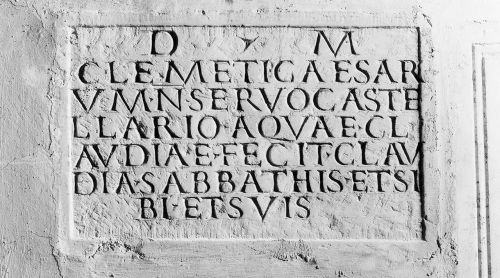



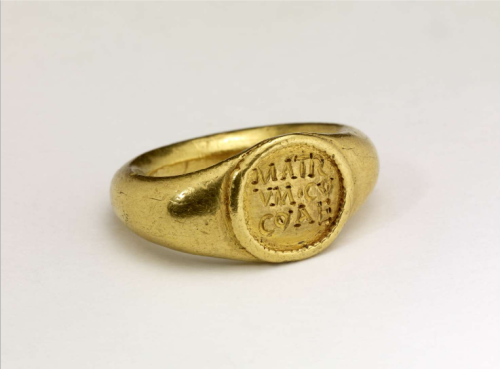
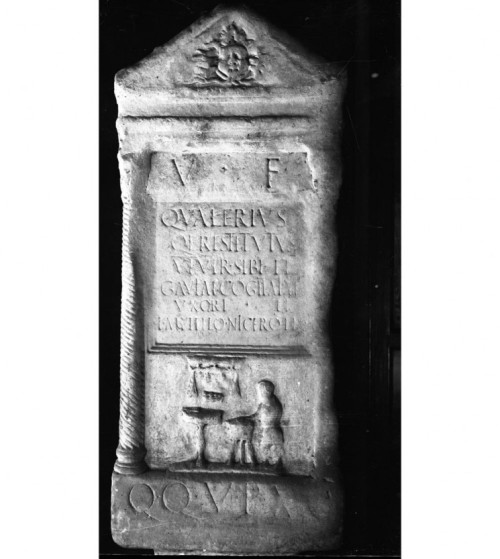
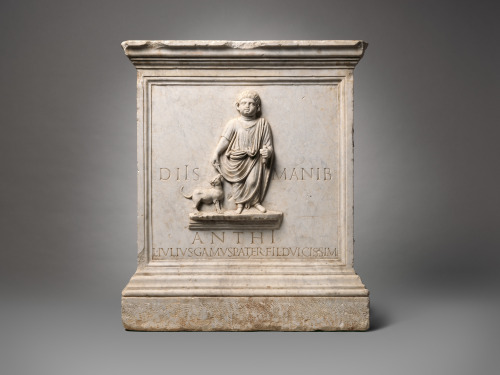

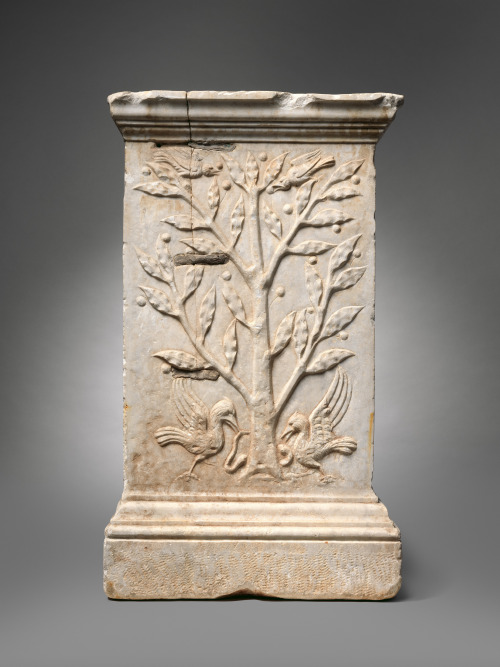
![Fragment of roman brick with the orbicular stamp Duor(um) [Le]sagor(um)meaning “(Brick Stamp) of Fragment of roman brick with the orbicular stamp Duor(um) [Le]sagor(um)meaning “(Brick Stamp) of](https://64.media.tumblr.com/4d46411311596b8212ae63ae5abdeaac/40761ccac4a4a369-55/s500x750/c99e968e9af10b2290a0aea7776bcee296eeace3.jpg)